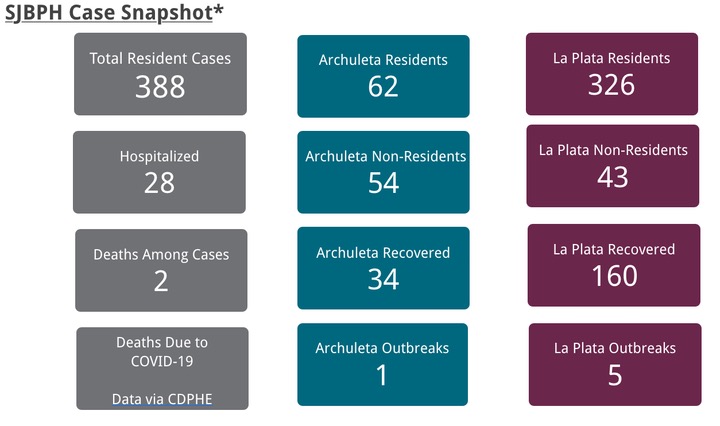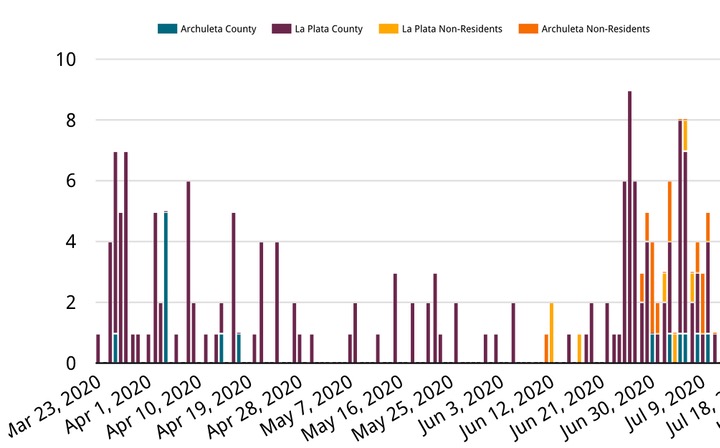There are definite disadvantages to being a small town, with a small n… if you’re concerned with statistics… during a pandemic.
The small n refers to a ‘small number of participants.’ Statistical methods of sharing information — problematic in the first place, for various reasons — are even less relevant when the number of participants in the sample is small.
For example.
One of our Daily Post readers wrote us last weekend with a question about coronavirus infections, and how they’re being reckoned by San Juan Basin Public Health (SJBPH), our local health district. SJBPH has a ‘dashboard’ on their website, here, where they share some information about COVID-19 testing and confirmed cases.
Here’s one section of the dashboard for this morning, Wednesday October 14, 2020. The totals shown are cumulative since March 23, 2020.
Our reader had noticed six new Archuleta County cases posted last week, and the new mention of “1 Outbreak” and was curious about the numbers — and more specifically, wondered where the “Outbreak” had occurred.
Claire Ninde, Director of Communications at SJBPH, provided this additional information:
The cases in Archuleta County this week are not related to the outbreak listed for Archuleta County on our data dashboard. The cases this week are related to household transmission and gatherings.
Through a combination of laboratory testing and epidemiological investigation, San Juan Basin Public Health (SJBPH) has identified a COVID-19 outbreak at a hunting camp located in Archuleta County. One guide and three hunters have been confirmed as COVID-19 cases; the guide is a resident of Archuleta County while the hunters are from out of state, Texas and Oklahoma.
The outbreak investigation is ongoing, and additional cases or contacts may be identified.
Because this outbreak crosses jurisdictional lines, SJBPH and CDPHE are working together to reduce the spread of the virus and risk to public health. Due to the remote location of the hunting camp the exposure risk to the community is low. Despite the low risk, SJBPH strives to demonstrate transparency in its COVID-19 reporting by providing as much information as possible to community members.
In order to protect the privacy of the individuals, identifying information and medical information about the persons involved will not be released to the public.
SJBPH continues to stress that the best ways to prevent the spread of COVID-19 are staying at home as much as possible, practicing physical distancing (at least 6 feet away from another person), wearing face coverings when in public, and practicing good hygiene (washing hands, covering coughs and sneezes, etc.)
SJBPH appreciates the efforts of both businesses and individuals to prevent spread of the disease by implementing strong public health practices.
The SJBPH website also publishes a chart, on Page Two, that tracks the changes in confirmed cases since March 23. This morning, the chart looked like this:
The chart displays four categories of cases: La Plata County residents, Archuleta County residents, La Plata County non-residents and Archuleta County non-residents. As we see, our region saw very few cases during April and May, and nearly all the confirmed cases were in La Plata County. (purple). But the numbers jumped in June and July, and we saw more non-resident cases… and more cases in Archuleta County.
Here’s a closer view of the first half of the chart, from March 23 through July 11.
As we see, the community began to see ‘non-resident cases in early July. Archuleta County saw very few cases through July 11.
Here’s a closer view of the second half of the chart, from July 11 through through October 12. The peak of new cases hit 10 per day in the middle of July. Near the end of August, the numbers declined… but starting in mid-September, we saw the cases increase once more.
The ‘small n’ problem becomes apparent if we look closely at the number of cases illustrated by these various vertical lines. The largest number of cases confirmed on a single day was “10”. When the number of new cases jumped in early October, the highest number of confirmed cases on a single day in Archuleta County was “4”.
Four cases, in a community that claims 14,000 residents and thousands of tourist visits, is not a terribly significant number. But when a chart attempts to illustrate — accurately — the new reported cases, and when the highest daily total shown is “10”, and when the number of new case per day is typically less than three, then four new cases can look rather dramatic.
My comments are not meant to minimize the danger of the novel cornonavirus, nor to minimize the suffering of the folks who have become infected. And we can all recognize that ‘social distancing’ and the wearing of face masks may have played a role in keeping these daily numbers statistically low. Knock on wood.
I simply wanted to explore, this morning, the problem of a small n in a small town. You might also want to read the article by Faith Miller, posted today, concerning an ‘alarming rise’ in Colorado COVID cases.




